As the University’s Orientation and Mobility (O&M) and Vision Rehabilitation Therapy (VRT) programs each celebrated their 30th anniversaries, there has been one constant throughout those three decades — how related they are to their optometric colleagues in the University’s Pennsylvania College of Optometry (PCO).
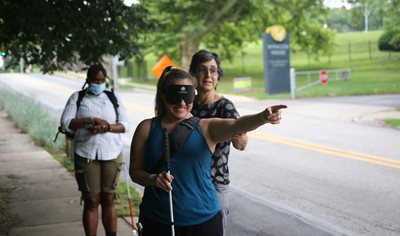 “Not only in our history, but in our goal, which is to provide comprehensive care for people with low vision or blindness,” said Fabiana Perla, MS ‘93, EdD, COMC, CLVR, director of the Blindness and Low Vision Studies (BLVS) department. “We open the doors for patients to be independent — maintaining independence and enhancing independence — to have access to information, education, travel and all the activities of daily living.”
“Not only in our history, but in our goal, which is to provide comprehensive care for people with low vision or blindness,” said Fabiana Perla, MS ‘93, EdD, COMC, CLVR, director of the Blindness and Low Vision Studies (BLVS) department. “We open the doors for patients to be independent — maintaining independence and enhancing independence — to have access to information, education, travel and all the activities of daily living.”
All programs in the University’s BLVS department work with their colleagues in optometry to make sure individuals have been taken care of from a health standpoint, then O&M and VRT provide compensatory strategies for vision.
"You can learn to ‘see’ with your ears, read with your hands, you can learn to travel even in the absence of vision. And, all those things we bring to the table,” said Dr. Perla.
How It All Began
It was on Nov. 9, 1992, when the University’s founding college, PCO, received authorization from the Pennsylvania Department of Education to grant Master of Science degrees to both O&M and VRT.
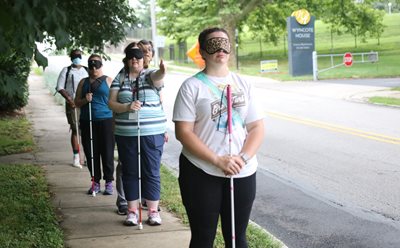 From its inception, the BLVS department has been closely associated with PCO. Thirty years ago, it lived in what was called the Department of Graduate Studies. What started as a small program with only a few students has grown to be an integral part of the College of Health Sciences, Education and Rehabilitation (CHER) with students from all over the world. That international reach, along with accreditation of the O&M and VRT programs from the Association for Education and Rehabilitation of the Blind and Visually Impaired (AER), are among the accomplishments of the programs in the first three decades.
From its inception, the BLVS department has been closely associated with PCO. Thirty years ago, it lived in what was called the Department of Graduate Studies. What started as a small program with only a few students has grown to be an integral part of the College of Health Sciences, Education and Rehabilitation (CHER) with students from all over the world. That international reach, along with accreditation of the O&M and VRT programs from the Association for Education and Rehabilitation of the Blind and Visually Impaired (AER), are among the accomplishments of the programs in the first three decades.
“The programs have grown to serve not only people who are entering the field but we have also positioned ourselves fundamentally as one of the programs that serves those already in practice through micro-credential courses and continuing education,” said Dr. Perla. Also, the programs are integrated into patient care at the University clinics. That’s an advantage for students in terms of inter-professional practice and the kinds of unique experiences they can experience from that approach.
The Evolution of Orientation and Mobility
When Jamie Maffit, MS ‘06, COMS, CLVT started as a student at PCO in 2004, the O&M program was in the phase of shifting from 100 percent in-person, which was the standard for most educational institutions at the time. As the need for O&M professionals grew, the in-person instruction became a burden for students who didn’t have a program nearby, particularly in rural areas of the country.
“In response to that, the faculty envisioned meeting the need in those rural areas by offering a hybrid program,” said Maffit. “Now, where we are today, the bulk of the program is online. We do have a summer residency and a fall residency. But this transition really was ahead of the curve.”
Maffit was recruited by then dean Dr. Audrey Smith, PhD, CLVT, COMS, to be part of the O&M faculty in 2011. She was then named director of the program in 2017.
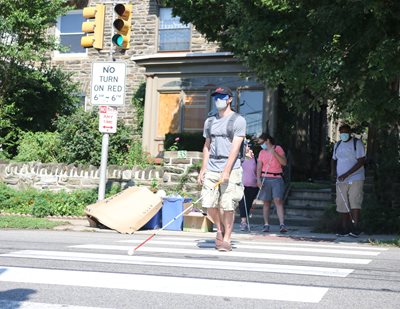 O&M specialists teach children and adults with blindness or low vision impairments critical skills to remain oriented in their environment as well as specific mobility skills to travel safely, efficiently and as independently as possible within the home, school, at work and in the community.
O&M specialists teach children and adults with blindness or low vision impairments critical skills to remain oriented in their environment as well as specific mobility skills to travel safely, efficiently and as independently as possible within the home, school, at work and in the community.
“We’ve always been positioned as an institution with a department of Blindness and Low Vision Studies as looking ahead and seeing how we can respond to the ever-changing environment and landscape,” said Maffit. Now, housed in the CHER alongside other health professions including Biomedicine, Speech-Language Pathology (SLP), Physician Assistant (PA) Studies, Occupational Therapy (OT), and Orthotics and Prosthetics (O&P), there are many opportunities to support inter-professional education.
Additionally, O&M and VRT services are now provided for patients of the William Feinbloom Rehabilitation Center housed at The Eye Institute (TEI) in the Oak Lane section of Philadelphia and on the Elkins Park, Pennsylvania campus. “Our students have the opportunity to learn collaboratively among a team of inter-professional colleagues to complete their direct service courses,” said Maffit. A testament to the program, ACVREP reports that the exam pass rates of Salus students are rated among the highest in the country.
The Evolution of Vision Rehabilitation Therapy
Lachelle Smith, MS ‘03, CVRT, had a similar experience when she went through the VRT program starting in 2000. At that time, she had only one course that was offered online, with the rest being held in person. Doing it that way, it took her three years to complete the program. But now that the program is hybrid, students can finish within four to five semesters minimum.
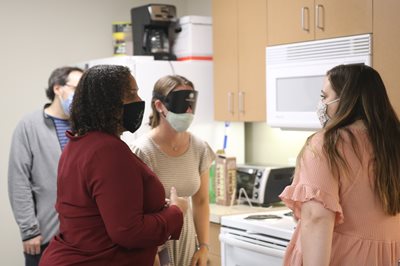 The VRT program is offered primarily online now with the exception of the summer residency, where students learn the instructional strategies for training individuals with visual impairments in the Activities of Daily Living (ADL) lab on the University’s Elkins Park, Pennsylvania campus.
The VRT program is offered primarily online now with the exception of the summer residency, where students learn the instructional strategies for training individuals with visual impairments in the Activities of Daily Living (ADL) lab on the University’s Elkins Park, Pennsylvania campus.
During the summer residency, students learn techniques about low vision, how to perform functional vision evaluations and orientation and mobility skills such as how to safely guide a person and teach strategies for indoor movement safely and efficiently.
In addition, the summer residency is where students learn the specific adaptive independent living skills techniques under blindfold and low vision simulators that will be used for training individuals seeking VRT services in the areas of home management, personal management, communication, recreation and leisure, basic home maintenance, and employment related activities.
“For the majority of our students that enroll in the VRT program, it’s a change of career completely. But for some students, adding the VRT specialty is a way to expand their skills and provide additional services,” Smith said. “For example, some students are working as teachers of students with visual impairments (TVIs) already but now they want to add on vision rehabilitation therapy.”
What sets the Salus VRT program apart, Smith believes, is teaching the non-visual skills.
“I call the VRTs the general practitioners of blind rehabilitation,” she said. “We are the original profession in the blindness field. We started in the mid-1800s under the title of ‘home teachers.’ This profession started out with individuals who were blind teaching other people who were blind how to live independently, how to find employment, work and take care of themselves.”
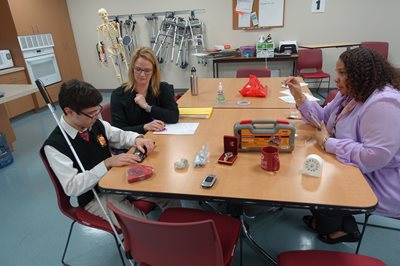 There was a time, Smith said, when those born with a disability, especially blindness, were separated from society and often institutionalized. But blind people wanted to contribute to their lives and live and work independently. So they started figuring out ways to take care of themselves. That in time evolved into the VRT profession.
There was a time, Smith said, when those born with a disability, especially blindness, were separated from society and often institutionalized. But blind people wanted to contribute to their lives and live and work independently. So they started figuring out ways to take care of themselves. That in time evolved into the VRT profession.
She added that what she loves most about being a VRT is that she is granted “the awesome responsibility” to empower others to live their best lives.
“The client gets to choose the level of independence they are most comfortable with and I get to empower them with knowledge and skills and resources to help them achieve that goal,” said Smith. “I’m not just helping them, I’m helping them help themselves. That’s the enlightening, empowerment, and encouragement I enjoy passing on to students. And, then when you do that, you see them pass that information along to others - that’s the best feeling.”